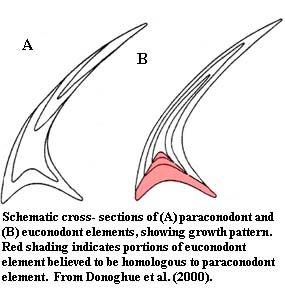
| Palaeos: |  |
Conodonta |
| The Vertebrates | Conodonta |
| Page Back | Unit Home | Unit Dendrogram | Unit References | Taxon Index | Page Next |
| Unit Back | Vertebrates Home | Vertebrate Dendrograms | Vertebrate References | Glossary | Unit Next |
|
Abbreviated Dendrogram
Vertebrata | |--+--Pteraspidomorphi | `--Gnathostomata | Conodonta |--Paraconodontida `--Euconodonta |--Proconodontidae `--+--Protopanderodontida `--Prioniodontida |--Balognathidae `--+--Prioniodinida `--Ozarkodinida |
Contents
Index |
Range: Middle Cambrian to Late Triassic (near extinction in Early Permian, followed by brief recovery)
Phylogeny: Vertebrata: (Pteraspidomorphi + Thelodonti) + *: Paraconodontida + Euconodonta.
Characters: bilaterally symmetrical vermiform (worm-like) animals; eyes present; conodont elements appear to be mouth parts; elements grew through successive addition of apatite layers around a basal cavity & usually capped by a tooth-like cusp; shapes depend n unequal addition of apatite; processes created by expansions may be capped with denticles, ridges, etc.; V-shaped myomeres; .
Notes: [1] the existence of a basal cavity is thought to mean that the elements grew within an epithelial pocket of the animal. [2] simple coniform types dominant in Cambrian first half of Ordovician. Compound elements (ramiform, pectiniform, etc.) first occur in Furongian and dominate after the Middle Ordovician. During Early Silurian, coniforms prevalent in off-shore faunas, while compound types were more numerous in nearshore environments. Coniform types disappeared after Early Devonian. [2] conodont elements known from ~50My prior to first bony scales from fish (Sacabambaspis).
Image: from Conodont Collection, James Davison
Links: Brazilian Conodonts; Euconodonta; Conodont Collection, James Davison; Conodonta; con-nexus; Armed to the teeth; Boggy's links to Conodonts; Conodonta after Sweet & Donoghue, 2001; ICRIODUS; miscinvs.htm; PALAEONTOLOGIA POLONICA, vol. 58; Muzeum Geologiczne - Konodont (Polish); World of Conodonta. APW040316.
 Paraconodontida:
(= Paraconodonta) Prooneotodus
Paraconodontida:
(= Paraconodonta) Prooneotodus
Range: Middle Cambrian to Early Devonian (?)
Phylogeny: Conodonta: Euconodonta + *.
Characters: Relatively simple forms with simple cones [SD01]; single tissue layer probably homologous with basal body of euconodonts [D+00] [SD01]; elements relatively poorly mineralized [D+00]; growth proceeds by adding to margins & base, but not tip [D+00].
Note: no soft tissue remains of paraconodonts are known. However, the group may be paraphyletic and include euconodonts. The material of paraconodont elements, as well as of euconodont basal bodies, is believed to be a dentine homologue.
Links: confabs98.html (Cochrane abstract); Progressive Palaeontology - Titles and Abstracts - PAGE 4 (another Cochrane abstract); Jerzy Dzik's home page; Re: Conodont elements; Re: Conodont elements.
References: Donoghue et al. (2000) [D+00]; Sweet & Donoghue (2001) [SD01]. APW040316
Range: Middle Cambrian to Late Triassic.
Phylogeny: Conodonta: Paraconodontida + *: Proconodontidae + (Protopanderodontida + Prioniodontida).
Characters: Large, anterior-most cups, believed to be eyes with extrinsic eye muscles; notochord not reaching most anterior portion of cranium; existence of brain inferred from encephalization of sensory structures; complex, poorly-understood tooth-like "conodont elements" formed in calcium phosphate (bone?) in head region; elements include grasping ramiform ('S' and 'M') elements and transverse (biting?) comb-shaped 'P' elements; conodont elements may have rasping function like hagfish and lampreys; 'P' elements may be velum homologue; conodont elements with precise occlusion suggested by microwear; elements formed poorly mineralized, finely crystalline base (probably dentine) and highly mineralized, coarsely crystalline crown (probably "homologous to enamel"); possible gill pouches; long, eel-like body with simple, V-shaped myomeres; fast-twitch fibers may not be present; possible longitudinal septum; 2-lobed (hypocercal?) caudal fin with radials, but no evidence of fin musculature; indeterminate growth
Links: Euconodonta; Conodonts; Hidden World of the Conodonta; Conodont apparatus model; Andrew MacRae - current projects; Conodonts; Scolecodont Definitions; What Are Conodonts?; The Pander Society - International Conodont Research; MsoDockBottom; CMM Research - Dr Anne Kemp; Meeting Reports.
References: Donoghue et al. (2000); Gabbott et al. (1995); Janvier (1995); Purnell (1995); Zimmer (2000).
Note: Estimated 65% of all jawless vertebrate species are conodonts, but the taxon was known only from conodont elements until 1983. A few body fossils are now known primarily from lagerstätten in Scotland and South Africa. The euconodonts are probably descended from the paraphyletic Lower Cambrian Paraconodontida; but this taxon is only known from crownless basal mineralizations and no soft tissue is known. The still more primitive Pre-Cambrian Protoconodonta are believed to be unrelated. APW040316.
Range: Middle Cambrian? to ?
Phylogeny: Euconodonta: (Protopanderodontida + Prioniodontida) + *.
Note: not to be confused with Protoconodontida, which are probably non-chordate (chaetognath) remains. APW040316.
Range: Early Ordovician to ?
Phylogeny: Euconodonta:: Prioniodontida + *.
Characters: apparatus having a pair of incisor-like (M?) elements in front, a set of four pairs of relatively gracile (S?) elements connected into a single unit by one posteriorly located symmetrical (S0?) element, and two pairs of robust (P?) elements hidden within the throat.
Links: Protopanderodontida; Jerzy Dzik's home page. APW040316.
| Page Back | Unit Home | Page Top | Page Next |
checked ATW040316